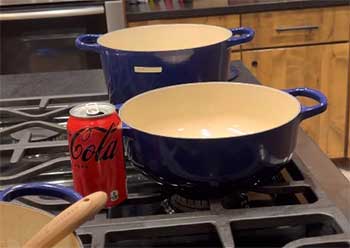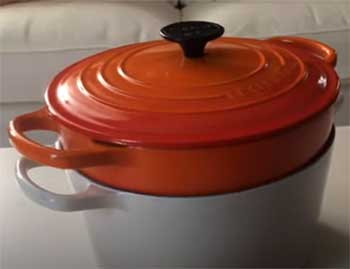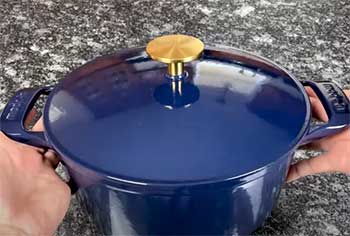Of all the cooking pots that people use all over the world, one of the most versatile is the Dutch oven. From roasting to slow cooking, frying, and baking, a Dutch oven can do it all.
There are two different types of Dutch ovens. There is the deep Dutch oven and the regular one.
The main difference between the deep and regular variants is that deep Dutch ovens have greater depth, allowing for cooking larger quantities of food. In this article, we will be comparing the very popular Le Creuset regular and deep Dutch ovens.
A Quick Comparison Table
| Specification | Deep Dutch Oven | Regular Dutch Oven |
| Capacity | 5 and a 1/4 qt. | 4 and a 1/2 qt. |
| Material | Cast iron with enameled surface | Cast iron with enameled surface |
| Servings | 5 to 6 people | 3 to 4 people |
| Dimensions | 13 inches wide with handles, 7 and a 1/2 inches tall with lid, 7 and a 1/2 inches in diameter | 12 and 3/4 inches wide with handles, 6 and a 1/2 inches tall with lid, 9 and a 1/2 inches in diameter |
| Extra Features | Compatible with all heat sources, dishwasher-safe, oven-safe up to 500F | Compatible with all heat sources, dishwasher-safe, oven-safe up to 500F |
| Price | Competitive | Around $390 |
Key Differences Between Le Creuset Deep Dutch Oven And Regular Oven
After going through the comparison table, you should now have a fairly good idea about the features and characteristics of the two kinds of Dutch ovens.
Now, let’s go a bit more in-depth into the characteristics of the products and really break down and discuss each characteristic separately.
- Pot Capacity

The characteristic we will start with is the capacity of both pots. This is where the key difference between the two lies.
A deep Dutch oven, as the name implies, has a greater depth and capacity than a regular one.
Le Creuset’s deep Dutch ovens have a capacity of 5 and 1/4 quarts. This makes the pot ideal for cooking big meats and large quantities of stews.
The regular Le Creuset Dutch oven has a capacity of 4 and a 1/2 quarts. This makes the pot slightly smaller in depth compared to the deep Dutch oven.
- Pot Material
Dutch ovens can be made of many different materials. Some of the most common ones are stainless steel, bare cast iron, and ceramic.
Both Le Creuset’s deep and regular Dutch ovens are made of high-quality cast iron with an enameled cast iron surface.
The bare cast iron exterior provides a strong and durable body. On the other hand, the enameled cast iron surface gives it a non-porous finish that minimizes sticking and staining.
Another advantage of the enameled surface is that, unlike bare cast iron, enameled cast iron does not rust and can be washed very thoroughly without damaging the material.
However, this comes with the caveat that enameled cast iron has a lower heat tolerance compared to bare cast iron. Temperatures above its tolerance level can crack or damage the enamel.
Good-quality enameled cast iron is also many times more expensive than regular cast iron.
- Number of Servings

Another important difference between Le Creuset’s deep and regular Dutch ovens is the number of people they can serve.
As mentioned before, the deep Dutch oven by Le Creuset has a greater depth than the regular one.
This allows you to easily serve 5 to 6 people with a dish cooked in it.
So, if you ever have guests over for dinner, the Le Creuset deep Dutch oven could be the perfect pot to use to whip up something that is sufficient enough to feed everyone.
On the other hand, the regular Le Creuset Dutch oven has a smaller depth than the deep variant. The regular Dutch oven has a serving capacity of 3 to 4 people. This makes the pot perfect for cooking up a nice family meal.
- Dimensions Of The Pots
The dimensions are another place where the deep and regular Dutch ovens differ greatly.
The Le Creuset deep Dutch oven is around 13 inches wide, including the handles on either side. The regular Dutch oven is slightly smaller, being around 12 and 3/4 inches wide, including the handles.
The deep Dutch oven is about 7 and a half inches tall with the lid on. However, the regular one is an inch shorter, measuring around 6 and a half inches tall with the lid.
As for the diameter, the deep Dutch oven has a diameter of 7 and a half inches. In this case, however, the regular Dutch oven is 2 inches larger in diameter, coming in at 9 and a half inches.
- Extra Features of Both Pots
Now, let’s talk about some extra features of both the deep and regular Dutch ovens by Le Creuset.
Both ovens are compatible with any kind of heat source available in most households. Both pots can be safely used on gas, electric, and induction stoves.
They are also dishwasher-safe, although it is recommended that you wash them by hand.
As mentioned before, the enameled cast iron surfaces of both pots cannot handle as much heat as regular cast iron. However, both pots are perfectly usable in any oven as long as the heat does not go over 500 degrees Fahrenheit.
- Versatility
Both the Le Creuset Deep Dutch Oven and the regular oven are versatile in their own ways. The Deep Dutch oven can be used on the stovetop or in the range, making it ideal for searing, sauteing, roasting, and braising.
Moreover, it is excellent for slow-cooking recipes requiring a long cooking time. Especially simmering soups, stocks, and stews become more suitable with the Deep Oven.
On the other side, the regular oven is great for roasting, baking, and broiling. But simmering stuff might be bad with a Regular Dutch Oven because of the shallow design.
So, you can choose the Deep Dutch Oven for a more versatile option.
- Cooking Time
Cooking time is a crucial factor for every chef and cook enthusiast. From the scientific perspective, more extensive and more profound pots consume more time to cook.
The Le Creuset Deep Dutch Oven requires long periods of cooking time. The cast iron construction and slow cooking allow for even heat distribution and retention. It helps to tenderize meats and infuse flavors into stews and soups.
But this whole process makes the cooking time much longer. However, it can sometimes increase the taste of the food.
Conversely, the regular oven is excellent for dishes requiring shorter cooking, such as roasts, casseroles, and baked goods. Because of its design, shape, and magnitude, it cuts down the food preparation time.
- Size and Design
One of the significant differences between the Le Creuset Deep Dutch Oven and the regular oven is the size and design.
The Le Creuset Deep Dutch Oven is designed to be deeper than the regular oven, allowing you to cook larger quantities of food.
This feature makes it ideal for cooking stews, soups, and other one-pot meals that require a lot of liquid.
On the other hand, the regular oven is shallower and more comprehensive, making it ideal for roasting meats, vegetables, and casseroles.
- Overall Efficiency
The overall efficiency depends on several factors like cooking time, number of servings, versatility, capacity, and purpose.
The Deep Dutch Oven is relatively more efficient regarding more significant food arrangements. Bigger pot size and deeper design keep the food-making process mess-free and more convenient.
But, considering the cooking time, the Regular oven takes over the efficiency crown. However, both ovens are an excellent addition to the Le Creuset product lineup.
After considering the purpose of using, you find out which one is more beneficial or efficient for you.
- Price of the Pots

Finally, let’s talk about arguably the first factor people look into before purchasing anything: the price of pots.
Despite the differences between the deep and regular Dutch ovens by Le Creuset, they have very similar price tags.
According to Le Creuset’s official website, as of now, their deep Dutch oven goes for around $300. Their regular Dutch ovens, on the other hand, are sold for around $390.
Which Oven Should You Choose?
There is no definitive winner between the two. They both have similar functions, with some slight differences in their size, capacity, and serving capabilities.
If you are looking for a pot for everyday use for making meals for your family, the regular Le Creuset Dutch oven may be the one for you.
But if what you need is a pot that you can use to make large meals for many people, then you should choose the deep Dutch oven instead.
Frequently Asked Questions (FAQ)
Below are some frequently asked questions and their answers.
A deep Dutch oven is a variant with extra depth that contains splatters and reduces boilovers.
Depending on how many servings you typically prepare. For four servings, a four-quart Dutch oven is sufficient.
Le Creuset’s enameled cast iron Dutch ovens are ideal for deep frying.
A deep cast iron skillet is a good substitute for a Dutch oven.
Closing Words
To sum up this article on Le Creuset deep Dutch ovens and regular ovens, the deep Dutch oven is more suitable when larger servings are required.
When cooking for 5 to 6 people, the deep oven is the better option. But if you are cooking for 3 to 4 people, you should pick the regular.

Based on measurements, there doesn’t seem to be a significant difference between them. A 1/4 on width handle to handle is no big deal and if only an inch taller, then that is not enough in my opinion. I have several sizes of the dutch oven but not the tall one so would need to see the tall one in person to see if it would be useful to add to my collection (obsession!).